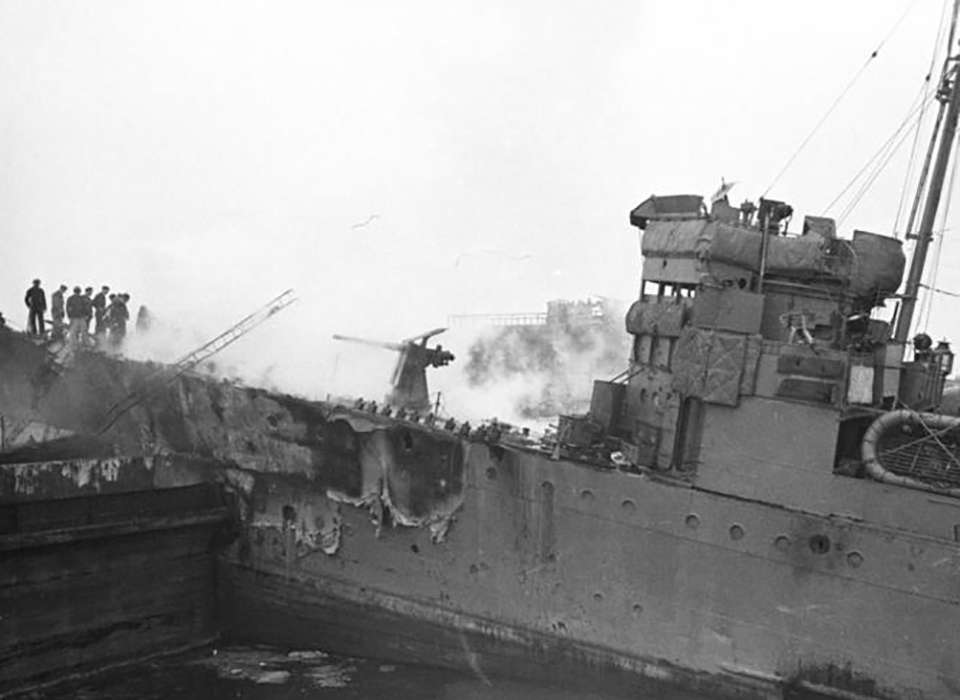During World War II, one of the most daring and audacious special forces operations carried out by British commandos was the St. Nazaire Raid, codenamed Operation Chariot. Taking place on March 28, 1942, the raid targeted the heavily fortified Normandie dry dock in St. Nazaire, France, a crucial facility that could accommodate the German battleship Tirpitz. The operation was a high-stakes mission designed to eliminate this strategic asset and disrupt the German Navy’s ability to project power in the Atlantic. The raid was a remarkable example of courage, planning, and determination, earning it the nickname “the greatest raid of all.”
Background and Strategic Importance
By 1942, the Kriegsmarine (German Navy) posed a significant threat to Allied convoys in the Atlantic, with warships like the Bismarck and Tirpitz capable of devastating attacks. While the Bismarck had been sunk in 1941, the Tirpitz remained a formidable menace. The Royal Navy feared that if the Tirpitz could use the Normandie dry dock for repairs, it would have free rein in the Atlantic, potentially crippling vital Allied supply routes.
The British devised Operation Chariot as a means to destroy the dock and prevent it from being used. Unlike traditional bombing missions, which had failed to damage the dock sufficiently, this plan involved a commando assault, using a modified destroyer packed with explosives to ram into the dock gates, followed by a team of commandos who would destroy key infrastructure before attempting an escape.
Planning and Preparation
The operation was meticulously planned by Combined Operations Headquarters, led by Admiral Louis Mountbatten. The core of the raid involved:
- HMS Campbeltown, an old Royal Navy destroyer modified to carry four tons of explosives in its bow.
- 18 small boats, including Motor Launches (MLs), to transport over 600 commandos from No. 2 Commando and supporting units.
- RAF support, although limited, to create a diversion during the attack.
The commandos were trained intensively for urban combat, demolition, and escape tactics. Due to the extreme nature of the mission, survival chances were considered low, but the volunteers were determined to carry out their objective.
The Raid: Execution of Operation Chariot
Approach and Initial Assault
On the night of March 27–28, 1942, the task force approached St. Nazaire under the cover of darkness. To deceive German defenses, HMS Campbeltown was disguised to resemble a German destroyer, flying a German flag until the final approach.
At 01:34 AM, the alarm was raised, and German coastal defenses opened fire. The Campbeltown, despite taking heavy damage, managed to crash into the dock gates precisely as planned. The commandos aboard quickly disembarked and set explosives on key targets, including pumping stations, dock machinery, and defensive positions.
Fierce Fighting and Destruction
As the commandos engaged in intense close-quarters combat, the MLs carrying reinforcements came under devastating fire, leading to severe losses. Despite this, demolition teams successfully planted charges that would cripple the dock beyond repair.
Meanwhile, the Campbeltown’s explosive payload, hidden in the bow, was set with a delayed fuse. By the time the Germans realized the ship’s true purpose, it was too late.
Explosive Climax and Aftermath
At 10:35 AM, the HMS Campbeltown exploded in a massive detonation, destroying the dry dock gates and rendering the facility unusable for the remainder of the war. The blast killed many Germans who had boarded the ship to inspect it, causing further chaos.
However, the escape plan was severely compromised. The surviving commandos attempted to withdraw through the town and countryside, but most were either killed or captured. Out of over 600 men involved in the raid, 169 were killed, and 215 became prisoners of war. Only 228 managed to escape back to Britain.
Impact and Legacy
Strategic Success
Despite the high cost in lives, the raid achieved its primary objective: the Normandie dry dock was put out of commission for the rest of the war, denying the Tirpitz a crucial repair facility. This effectively confined the battleship to Norwegian waters, preventing it from threatening Allied convoys in the Atlantic.
Recognition and Honors
The St. Nazaire Raid became one of the most highly decorated operations of World War II. A total of 89 gallantry awards were given, including five Victoria Crosses (VCs)—the highest military decoration for valor in the British armed forces. These awards recognized the exceptional bravery of those who took part in the mission.
Historical and Cultural Significance
- The raid demonstrated the effectiveness of combined operations, influencing future commando raids and special forces tactics.
- It is often referred to as “The Greatest Raid of All”, highlighting its daring nature and significant impact.
- The operation has been featured in various books, documentaries, and films, ensuring its legacy endures.
Conclusion
The St. Nazaire Raid remains one of the most extraordinary special operations of World War II. It showcased the bravery and ingenuity of British commandos, who succeeded against overwhelming odds. The destruction of the Normandie dry dock significantly hampered German naval operations and proved that even the most heavily defended targets could be struck with skill and determination. The legacy of Operation Chariot continues to inspire military strategists and historians, cementing its place in the annals of warfare as a defining moment of courage and sacrifice.

